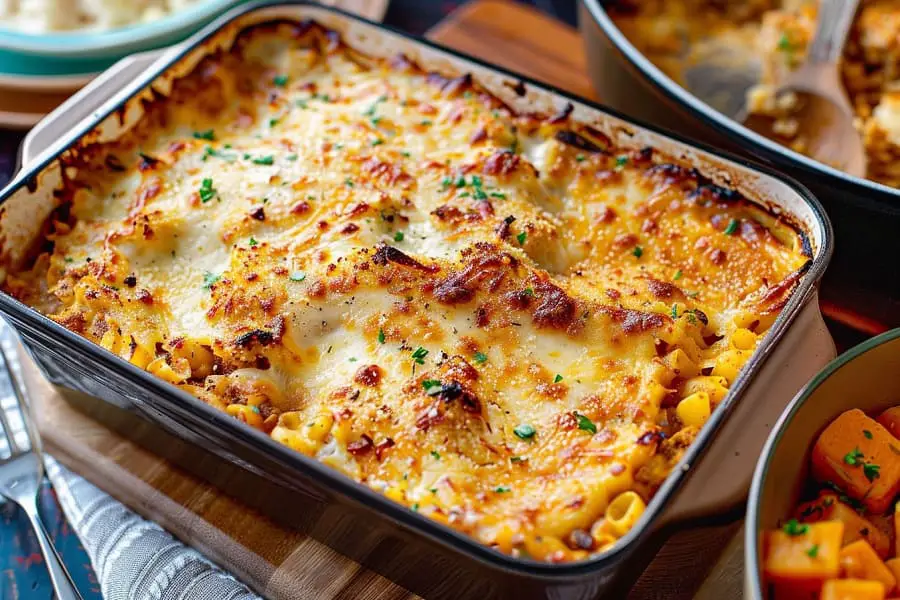When you’re craving a comforting, flavorful casserole, nothing is more disappointing than a dish that turns out bland or soggy. Whether you’re a seasoned cook or just starting, these quick tips will help you elevate your casseroles to new heights. Let’s dive into the most effective ways to make your casserole taste better—starting with simple, actionable advice you can apply immediately.
How do you make a casserole taste better ?
1. Season as You Go: The Key to Flavorful Casseroles
One of the most common mistakes is under-seasoning. Remember to season each layer of your casserole as you assemble it. This ensures that every bite is full of flavor and that no single ingredient overpowers the others. Whether it’s the protein, vegetables, or the sauce, make sure everything is well-seasoned before combining them.
2. Use Quality Broths Instead of Water
Replacing water with chicken, beef, or vegetable broth adds depth to your casserole. These broths infuse the dish with rich flavors that water simply cannot provide. For an extra boost, simmer your broth with herbs or a splash of wine before incorporating it into your casserole.
3. Add a Crunchy Topping
Prevent sogginess and add texture by incorporating a crunchy topping. Toppings like breadcrumbs, grated cheese, or crushed nuts not only improve the texture but also introduce an extra layer of flavor that enhances the overall experience.
4. Incorporate Acid for Balance
A touch of acidity can balance the richness of a casserole, making the dish more complex and flavorful. Consider adding tomatoes, a splash of vinegar, or a squeeze of lemon juice. These acidic elements cut through heavy flavors and brighten the overall taste of the dish.
5. Roast Vegetables for Extra Depth
Roasting vegetables before adding them to your casserole is a simple way to enhance their natural sweetness and deepen the flavor of your dish. Caramelized vegetables like carrots, parsnips, or mushrooms bring a savory complexity that raw or steamed vegetables can’t match.
6. Experiment with Herbs and Spices
Herbs and spices are essential for making your casserole taste vibrant and full of life. Fresh herbs like thyme, rosemary, and parsley, combined with spices such as smoked paprika or cumin, can transform a simple casserole into a gourmet meal. Garlic and onions are foundational ingredients that provide a robust base for any casserole.
Techniques to Improve Casserole Tast
Layering Flavors for Depth:
Layering is crucial for creating a casserole with depth. Season each component—proteins, vegetables, and sauces—individually. This approach ensures that every bite is bursting with flavor.
Incorporating Acidic Ingredients:
Acidic ingredients like tomatoes, vinegar, or lemon juice can balance the richness of a casserole and cut through heavier flavors.
Ingredient Swaps to Elevate Your Casserole
Healthier Substitutes without Sacrificing Flavor:
Looking to make your casserole lighter? Swap heavy cream for Greek yogurt or use a blend of milk and broth instead of full-fat dairy. Whole grain or vegetable-based noodles are great for added nutrients.
Gourmet Additions for a Taste Upgrade:
Elevate your casserole with gourmet additions like truffle oil, a splash of sherry, or aged cheeses such as Gruyère or Parmesan. These small touches add sophistication and depth.
Common Casserole Mistakes and How to Fix Them
Avoiding Soggy Textures:
To avoid a soggy casserole, be mindful of moisture levels. Pre-cook or sauté vegetables to remove excess water, and use a crunchy topping to add a satisfying texture.
Fixing Bland Casseroles:
If your casserole lacks flavor, a bit of acid or a sprinkle of salt can make all the difference. Don’t be afraid to taste and adjust the seasoning after baking.
Preventing Overcooking:
Overcooked casseroles can lose their signature casserole taste and become dry. Monitor cooking times closely, and cover the dish with foil if it starts to brown too quickly. Adding a bit of broth before reheating leftovers can help maintain moisture and preserve that rich casserole taste.
Recommended Tools and Products
Best Casserole Dishes:
Invest in a good quality casserole dish, such as ceramic or enameled cast iron. These materials retain heat well, provide even cooking, and are attractive enough to serve directly from oven to table.
Must-Have Kitchen Gadgets:
A mandoline is great for evenly slicing vegetables, and a microplane can help you finely grate cheese and zest citrus. These tools can streamline your preparation process.
FAQs
- What are the best herbs for casseroles?
Fresh herbs like thyme, rosemary, and parsley are excellent choices. Dried spices such as paprika, cumin, and garlic powder also work well. - How can I make my casserole healthier without losing flavor?
Substitute heavy cream with Greek yogurt or use broth instead of full-fat dairy for a lighter but still flavorful dish. - Why does my casserole turn out bland?
Your casserole might need more seasoning or a balance of acidity. Taste as you cook and adjust the flavors accordingly. - How do I prevent my casserole from becoming soggy?
Pre-cook your vegetables to remove excess moisture and consider adding a crunchy topping like breadcrumbs or cheese. - Can I prepare a casserole in advance?
Yes! Most casseroles can be assembled a day ahead and baked before serving. This allows the flavors to meld together even more.
Dicover alos :
What do you eat on the side of a casserole?
Try these tips in your next casserole and share your success with us on social media using #Tast yworth. For more quick and easy cooking tips, subscribe to our newsletter!

